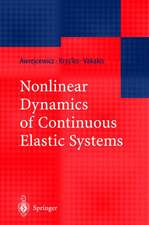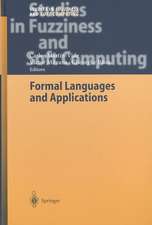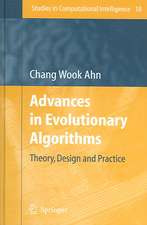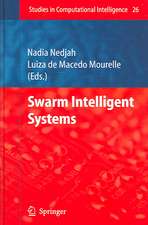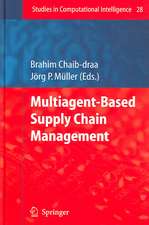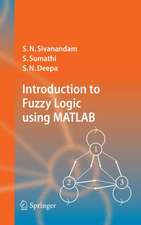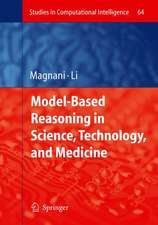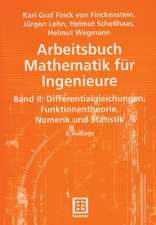Finite Element Concepts: A Closed-Form Algebraic Development
Autor Gautam Dasguptaen Limba Engleză Hardback – 6 dec 2017
| Toate formatele și edițiile | Preț | Express |
|---|---|---|
| Paperback (1) | 504.79 lei 38-44 zile | |
| Springer – 30 aug 2018 | 504.79 lei 38-44 zile | |
| Hardback (1) | 522.94 lei 38-44 zile | |
| Springer – 6 dec 2017 | 522.94 lei 38-44 zile |
Preț: 522.94 lei
Preț vechi: 645.60 lei
-19% Nou
Puncte Express: 784
Preț estimativ în valută:
100.08€ • 103.25$ • 84.70£
100.08€ • 103.25$ • 84.70£
Carte tipărită la comandă
Livrare economică 28 februarie-06 martie
Preluare comenzi: 021 569.72.76
Specificații
ISBN-13: 9781493974214
ISBN-10: 1493974211
Pagini: 335
Ilustrații: XXXVI, 333 p. 45 illus.
Dimensiuni: 155 x 235 x 23 mm
Greutate: 0.76 kg
Ediția:1st ed. 2018
Editura: Springer
Colecția Springer
Locul publicării:New York, NY, United States
ISBN-10: 1493974211
Pagini: 335
Ilustrații: XXXVI, 333 p. 45 illus.
Dimensiuni: 155 x 235 x 23 mm
Greutate: 0.76 kg
Ediția:1st ed. 2018
Editura: Springer
Colecția Springer
Locul publicării:New York, NY, United States
Cuprins
1. Bar.- 2. Trusses.- 3. 2-D Llinear Interpolation.- 4. Triangular Elements.- 5. Taig’s Convex Quadrilateral Elements.- 6. Irons patch test.- 7. Eight DOFs.- 8. Incompressibility.- 9. Conclusions.
Notă biografică
Dr. Gautam Dasgupta has been a member of Columbia University faculty since 1977. He has published in the areas of engineering mechanics and computer mathematics including graphics and music. He constructed numerical forms of the viscoelastic correspondence principle, introduced the cloning algorithm to model frequency responses of infinite (unbounded) media with finite elements, derived stochastic shape and Green's functions for finite and boundary element, and proved the Almansi Theorem for anisotropic continua.
Textul de pe ultima copertă
This text presents a highly original treatment of the fundamentals of FEM, developed using computer algebra, based on undergraduate-level engineering mathematics and the mechanics of solids. The book is divided into two distinct parts of nine chapters and seven appendices. The first chapter reviews the energy concepts in structural mechanics with bar problems, which is continued in the next chapter for truss analysis using Mathematica programs. The Courant and Clough triangular elements for scalar potentials and linear elasticity are covered in chapters three and four, followed by four-node elements. Chapters five and six describe Taig’s isoparametric interpolants and Iron’s patch test. Rayleigh vector modes, which satisfy point-wise equilibrium, are elaborated on in chapter seven along with successful patch tests in the physical (x,y) Cartesian frame. Chapter eight explains point-wise incompressibility and employs (Moore-Penrose) inversion of rectangular matrices. The finalchapter analyzes patch-tests in all directions and introduces five-node elements for linear stresses. Curved boundaries and higher order stresses are addressed in closed algebraic form. Appendices give a short introduction to Mathematica, followed by truss analysis using symbolic codes that could be used in all FEM problems to assemble element matrices and solve for all unknowns. All Mathematica codes for theoretical formulations and graphics are included with extensive numerical examples.
Caracteristici
The textbook is suitable for a two semester undergraduate or a one semester graduate course Suitable for engineering, applied mathematics and physics students Modeled for Civil, mechanical, bio-engineering and engineering mechanics disciplines Self-study, in styling the book, encourages researchers towards innovative and independent thinking Synthesizes numerics and graphics through symbolic computation Mathematica® routines, for transformation and closed form integration on arbitrary convex, concave and curved regions, can be easily integrated in any C++ code for production runs Also, appropriate for animation and augmented reality industries for color distribution and morphology Includes supplementary material: sn.pub/extras

